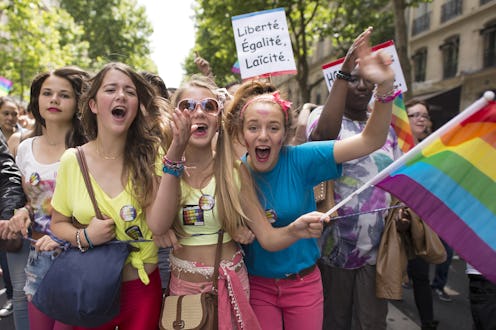Life
These Students Are 90% More Likely To Be Bullied
The incessant bullying of lesbian, gay, and bisexual youth is a despicable fact, but not a surprising one if you pay attention to the harassment, violence, and abuse faced by non-heterosexual people in our society. While there have been numerous research studies proving that young people who identify as lesbian, gay, or bisexual encounter more harassment and bullying than their straight classmates, most of this previous research has depended on older teens and adults reflecting on their childhood experiences. This new study by the New England Journal of Medicine, however, only includes presently young kids, and the research was gathered by following 4,268 students from fifth grade to 10th grade. It revealed that higher rates of bullying of LGB youth begins when the students are even younger than had been documented — before they are aware of or open about their orientation — and continues throughout their schooling.The researchers surveyed students from Alabama, Texas, and California, meeting with them for the first time as fifth graders. During these interviews, the students were not asked about their sexual orientations because, as stated in their research letter, elementary school is "before most youth are likely to be aware of or disclose their sexual orientation." The students were only asked questions about bullying, exclusion, and physical violence that they may have experienced, and reports of weekly incidents were recorded as bullying and/or victimization. In this survey, victimization refers to physical violence and social exclusion.The researchers then met with the same students again in fifth and 10th grade, and asked them to describe their sexual orientations and attractions during the final 10th grade interview — 21 percent of the girls and 8 percent of the boys expressed some level of attraction to their same sex.
What is now being described as one of the most interesting findings to come out of the research is that not only were these LGB youth still experiencing more bullying than their straight classmates, but that "even in the fifth grade," these same students who did not yet identify as homosexual or bisexual were still "at an increased risk for being bullied or victimized."
Dr. Mark Schuster, a lead author of the research article, suspects that one of the many reasons that this may occur is because "some kids may be viewed as 'gender variant' by their peers," and so many children are socialized to negatively understand gender fluidity.
As the surveyed students grew older, youths of all sexual orientations reported that they experienced less bullying, but lesbian, gay, and bisexual students still experienced more bullying and victimization than their straight peers. By the end of the research, throughout all grades, LGB students were approximately 91 percent more likely to be bullied, and 46 percent more likely to be victimizedthan the heterosexual students in their schools — an enormous and infuriating disparity that exists throughout their school years.
As Dr. Schuster says, "Bullying in general — as has been reported by others — decreases as kids go through school, but the disparity does not." Specifically, 8 percent of the straight students reported bullying in fifth grade, compared to 13 percent of the students who identified or later identified as lesbian, gay, or bisexual. When the students were interviewed again in tenth grade, 1 percent of the heterosexual students reported experiencing bullying, compared to 4 percent of the LGB students.
Likewise, peer victimization "was reported by about 21 percent of fifth-graders in the heterosexual group and about 26 percent of fifth-graders in the LGB group. By tenth grade, about 6 percent of heterosexual students and about 10 percent of LGB students said they were being victimized."Since the study focused on sexual orientation, the T in LGBT was not studied. However, the bullying and violence against trans folks and trans youth is horrifyingly prevalent as well. Seven trans women have already been murdered in 2015, six of whom were trans women of color, and it is only the beginning of May. Leelah Alcorn's suicide in December, and her devastating suicide note, became national news, and she is one of the 41 percent of trans people who will attempt suicide each year. In other studies, 82 percent of trans kids reported feeling unsafe at school, and 44 percent had experienced violence in school.
The bullying reported by LGBT youth are huge factors in their high suicide rates. Roughly 10 to 20 percent of LGB people have reported attempting suicide, and other studies have revealed links between identifying as lesbian, gay, or bisexual in elementary school and suffering from depression as an adult. Dr. Schuster stresses the importance of non-homophobic parenting in order to demonstrate progressive and accepting examples for kids of all sexualities. Homophobic parents either harm closeted children or children not yet aware of their sexualities, or encourage heterosexual children to bully and abuse LGBT kids.
Michelle Birkett, a research scientist at the IMPACT LGBT Health and Development Program of Northwestern University Feinberg School of Medicine in Chicago, explains, one of the most important defenses that LGBT youth can have in an unsafe culture, the existence of which is further proven by this study, is a support system beginning from a very early age. When many young people spend eight hours a day on various playgrounds and campuses for up to 12 years, a safe and supportive space must exist in school, no matter the grade.Images: Getty Images
